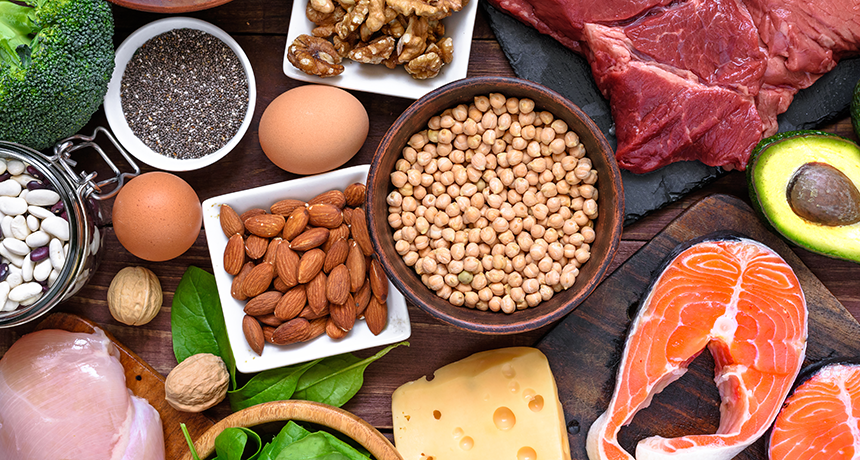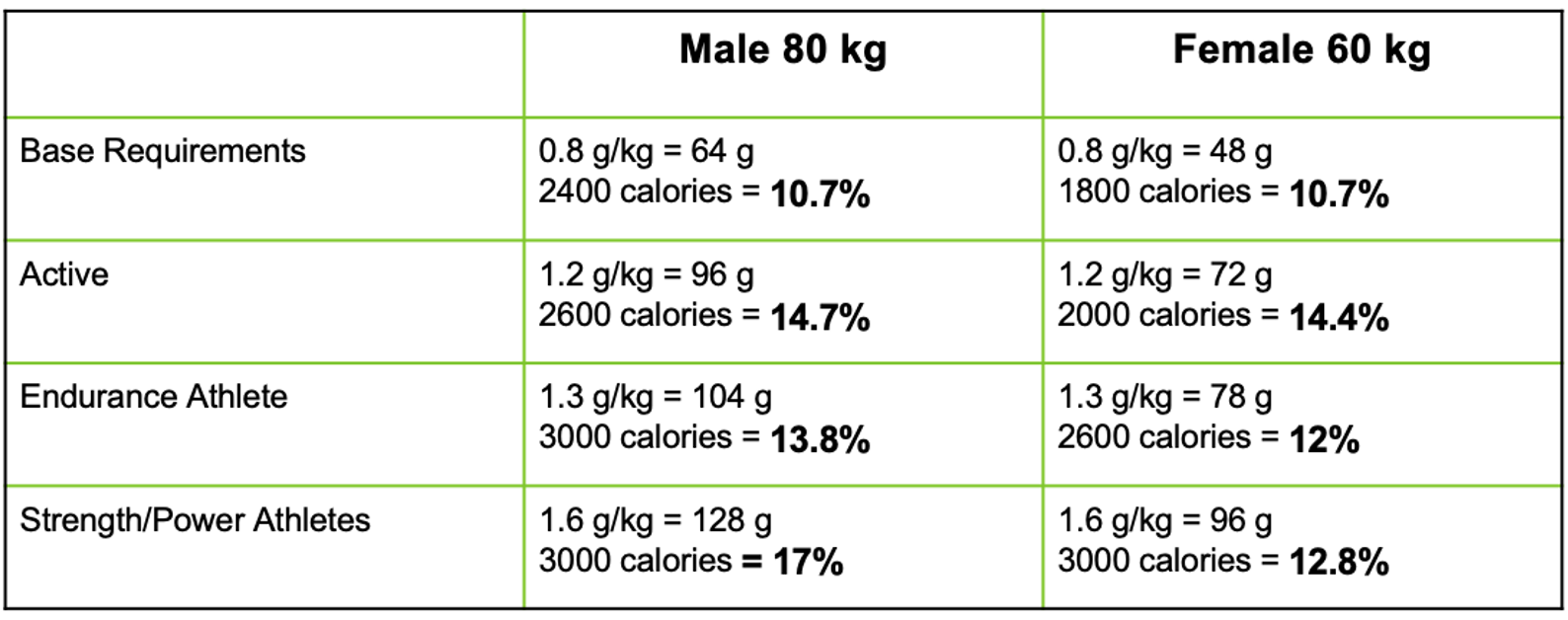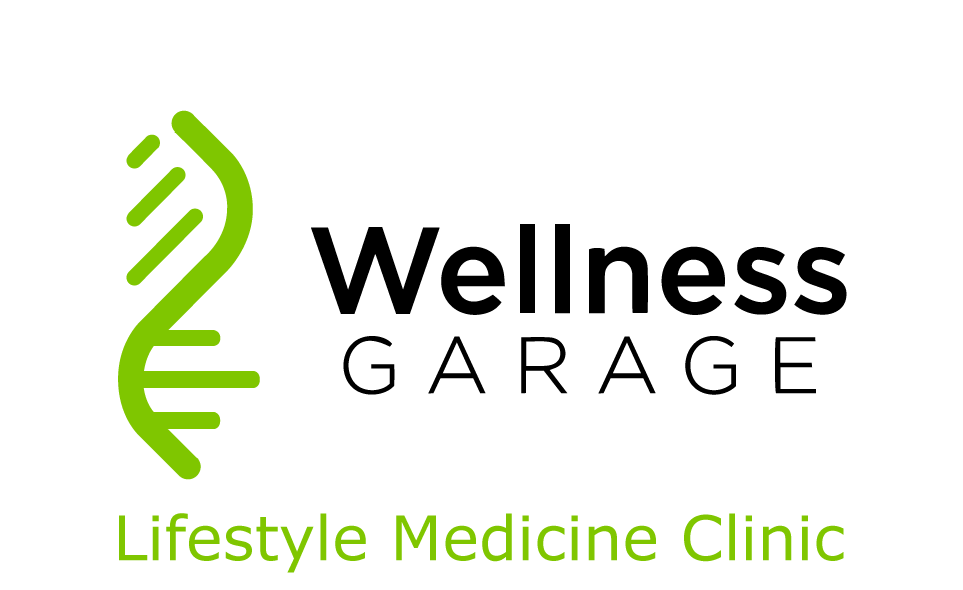|
The EAT Better Strategy:
When we eat food - it is broken down into 3 macronutrients:
When we eat proteins, they are broken down into amino acids - essentially the building blocks for new proteins. These amino acids are absorbed into the bloodstream and distributed around the body to tissues that need them. Dietary protein is predominantly used by our bodies for structure and function and not for fuel. The most important functional molecules of the body - hormones, neurotransmitters, enzymes and antibodies are proteins, as are our structural components - muscle, collagen, connective tissue, and even cartilage and bone. Our bodies need 20 amino acids to be able to create all the proteins that we need for life. Of these 9 are considered to be essential - meaning that we need to get them from our diets.
The body is very good at reutilizing amino acids, but is not fully efficient as some amino acids get damage and broken down. As a result, we always need a to eat some new protein just to maintain our existing proteins. Unlike fats and carbohydrates, we cannot store excess protein, so we are also dependent on our diets to provide enough protein for any growth and maintenance. Excess dietary protein, beyond levels required to restore amino acid balance, are degraded, the amino groups are broken down and excreted as urea, creatinine, uric acid or other nitrogenous metabolites. The remaining carbon skeleton which are keto acids are either utilized as fuel in the liver or converted into glucose or more likely fat. That’s right - excess protein will be turned into fat! This may seem surprising given the popularity of high protein diets for weight loss, but there are two other attributes of protein that may explain their benefit in a weight loss diet. First, of the macronutrients, protein is the most satiating. Meals with high protein feel more filling and decrease hunger for a longer period of time, and a result you will consume fewer calories overall. The other attribute of protein metabolism that helps with weight management is the fact that the process to convert protein into fat is inefficient and about a third of the energy in the protein is consumed in the process. A small percentage of protein is used to maintain blood glucose levels during fasted states. This process, gluconeogenesis, runs at a fairly constant rate throughout the day using multiple substrates including lactate (released from muscle glycogen) and glycerol (from fat breakdown). The amount of protein required for this is very small. Summary
How much protein do we need a day? The official answers from the Institute of Medicine are
0.8 g/kg is meant to be the minimum amount of protein we require without becoming deficient. This is the amount of extra protein our body needs for repair and maintenance or as we discussed above the amount of protein that is lost each day as we recycle our amino acids. As we are more active we need more protein - however the best evidence we have is that these requirements are still rather modest - with up to 1.6g/kg for strength/power athletes who are training to gain muscle mass. There is no evidence that we need beyond 2 g/kg per day. From these examples you can see that based on functional requirements the range of protein intake that we need is between 10-17% of our total calories. The average Canadian intake of protein is 17% Bottom Line: most people get enough protein. One interesting observation about how our bodies regulate protein comes from nutritional studies where subjects are allowed to eat as much food as they want. Overall, people tend towards overconsumption of fat or carbohydrates - especially if these come in refined and processed foods without fibre. When it comes to protein, most people will maintain a consistent protein intake of between 15-20% of their calorie consumption. So while our brains can struggle to regulate fat and carbohydrate intake well, we do self regulate on protein. The simple rule that can be taken from this observation is that when it comes to protein - listen to your body. If you feel like you need protein then be sure to increase your lean protein intake. Are there benefits to having more protein? As we have reviewed, extra dietary protein above and beyond our maintenance, growth and repair will predominantly get converted to fat. While this conversion consumes 33% of the caloric energy, if your overall caloric intake is excessive, you are still increasing your fat by consuming too much protein. The extra protein may however increase your satiation and result in the overall consumption of fewer calories in which case it will support weight loss or maintenance. One time where extra protein may be beneficial is your first meal of the day: break your fast with a meal containing at least 20-30 g of protein. This will signal your body that you have nutrients, increasing metabolic rate and will decrease ghrelin (your hunger hormone). If you are consuming more calories from protein than you require you must be careful and consider the package that comes with the protein - what fats, carbohydrates, vitamins, minerals, and other nutrients come along with protein? Eat protein that is low in saturated fat and processed carbohydrates and rich in many nutrients. Is there harm from eating too much protein? For many years, medical textbooks would caution against the harms of too much protein. Specifically the harmful effect of excessive nitrogen excretion from the kidneys. This harm was overstated - as a result the Institute of Medicine guidelines of 10 - 35%. From a longevity standpoint, there is a line of research from Dr. Valter Luongo suggests that high protein consumption is associated with higher rates of cancer, and diseases associated with inflammation. He specifically recommends that adults under age 65 consume no more than 0.7 g/kg and increase to 1 g/kg after age 65. What about protein for older adults? After age 50, we lose muscle mass through a process called sarcopenia, and as our muscle mass decreases we have less internal protein to recycle so the portion that we require from our diets increases. To help prevent, or at least decrease the rate of sarcopenia, the RDA for adults over 50 years is 1 g/kg. Most older adults easily reach this target, and for them the other key to maintaining muscle mass is resistance training. Regular exercise doing body weight exercises or weights has been shown to be the most effective strategy for sarcopenia. If you are like me these answers are hard to translate into our daily lives - what does this mean in terms of actual foods that I am going to eat? Are there differences in protein quality between plants and animal sources? Advocates of eating meat are quick to point out that animal sources are “complete” proteins, meaning that they contain all essential amino acids and fully meet protein requirements gram for gram. The problem with this line of thinking is that plants contain the same 20 amino acids, the origin of the amino acids in animals is originally from plants. Given that both animal and plant proteins are broken down into amino acids before absorption, there is NO fundamental difference between eating meat and eating a variety of vegetable sources of protein. (For more on this read Chana Davis’s excellent blog post: Busting the Myth of Incomplete Plant-Based Proteins. One factor in favour of plant protein over meat is that the plant packages have more micronutrients and fibre without the potentially harmful saturated fats found in meat. What about protein powder? The thing to ask yourself is why? Why are you taking protein powder instead of choosing a healthy whole food protein package? If it is to make your smoothie a satiating substitute for a meal that makes sense. If it is to get more protein into your body it is probably unnecessary. Remember that if you are consuming more calories than you need, that protein powder will get turned into fat! If you are going to choose a protein powder, the advice from Precision Nutrition is pretty good: Stick to the basics.
Summary
(That’s it - it really is that easy) Next - Add veggies, fruits, legumes, whole grains - (7 Reasons Why & 12 Tips How) |
AuthorDr. Brendan Byrne Categories
All
|


 RSS Feed
RSS Feed
